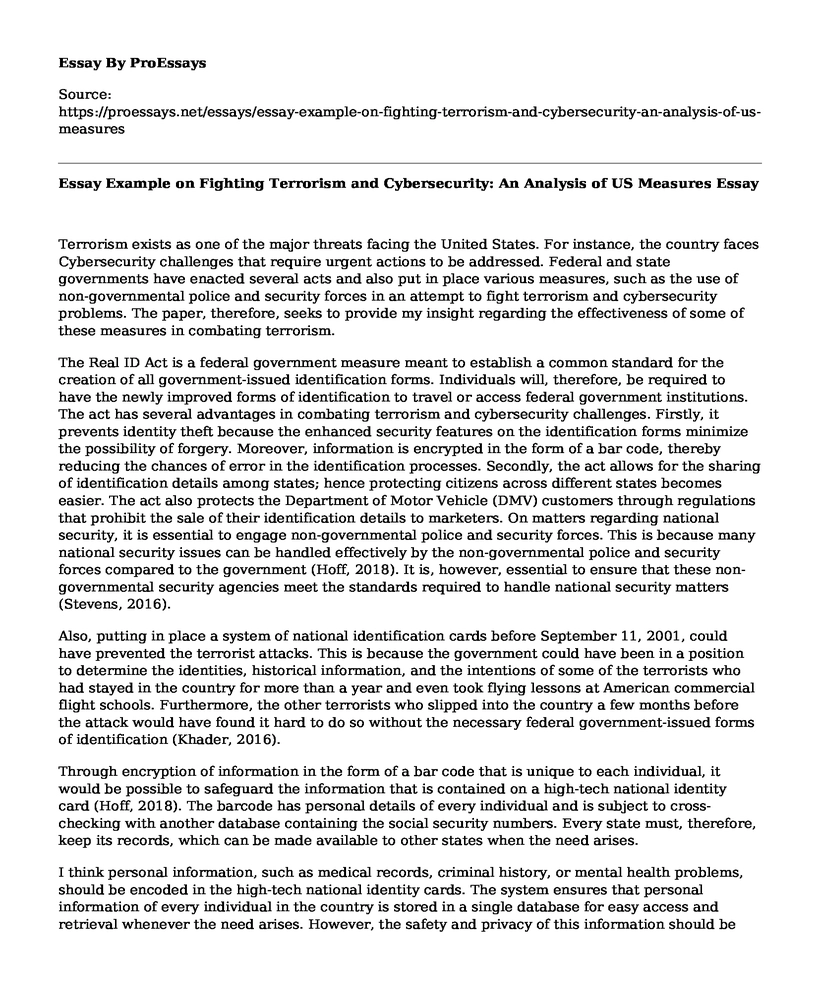Terrorism exists as one of the major threats facing the United States. For instance, the country faces Cybersecurity challenges that require urgent actions to be addressed. Federal and state governments have enacted several acts and also put in place various measures, such as the use of non-governmental police and security forces in an attempt to fight terrorism and cybersecurity problems. The paper, therefore, seeks to provide my insight regarding the effectiveness of some of these measures in combating terrorism.
The Real ID Act is a federal government measure meant to establish a common standard for the creation of all government-issued identification forms. Individuals will, therefore, be required to have the newly improved forms of identification to travel or access federal government institutions. The act has several advantages in combating terrorism and cybersecurity challenges. Firstly, it prevents identity theft because the enhanced security features on the identification forms minimize the possibility of forgery. Moreover, information is encrypted in the form of a bar code, thereby reducing the chances of error in the identification processes. Secondly, the act allows for the sharing of identification details among states; hence protecting citizens across different states becomes easier. The act also protects the Department of Motor Vehicle (DMV) customers through regulations that prohibit the sale of their identification details to marketers. On matters regarding national security, it is essential to engage non-governmental police and security forces. This is because many national security issues can be handled effectively by the non-governmental police and security forces compared to the government (Hoff, 2018). It is, however, essential to ensure that these non-governmental security agencies meet the standards required to handle national security matters (Stevens, 2016).
Also, putting in place a system of national identification cards before September 11, 2001, could have prevented the terrorist attacks. This is because the government could have been in a position to determine the identities, historical information, and the intentions of some of the terrorists who had stayed in the country for more than a year and even took flying lessons at American commercial flight schools. Furthermore, the other terrorists who slipped into the country a few months before the attack would have found it hard to do so without the necessary federal government-issued forms of identification (Khader, 2016).
Through encryption of information in the form of a bar code that is unique to each individual, it would be possible to safeguard the information that is contained on a high-tech national identity card (Hoff, 2018). The barcode has personal details of every individual and is subject to cross-checking with another database containing the social security numbers. Every state must, therefore, keep its records, which can be made available to other states when the need arises.
I think personal information, such as medical records, criminal history, or mental health problems, should be encoded in the high-tech national identity cards. The system ensures that personal information of every individual in the country is stored in a single database for easy access and retrieval whenever the need arises. However, the safety and privacy of this information should be guaranteed.
Conclusion
In summary, terrorism and cybersecurity challenges are part of serious security problems facing the U.S. It is, therefore, essential to take urgent action by putting necessary measures, both at governmental and non-governmental levels, needed to address these challenges. The measures taken should guarantee the privacy of personal information of individuals.
References
Hoff, H. (2018). Get Real: Implications and Impositions of the Real ID Act of 2005 on Vulnerable Individuals and States. Cath. UL, Rev., 68, 379. https://scholarship.law.edu/cgi/viewcontent.cgi?article=3499&context=lawreview
Khader, M. (Ed.). (2016). Combating Violent Extremism and Radicalization in the Digital Era. IGI Global https://www.researchgate.net/profile/Geoff_Dean3/publication/310953656_Framing_the_Challenges_of_Online_Violent_Extremism/links/583ba29908aef00f3bfd88b3/Framing-the-Challenges-of-Online-Violent-Extremism.pdf
Stevens, J. W. (2016). Combating Terrorism: North American Aerospace Defense Command versus Asymmetric Threats. Air Command and Staff College Air University Maxwell AFB United States. https://apps.dtic.mil/dtic/tr/fulltext/u2/1045774.pdf
Cite this page
Essay Example on Fighting Terrorism and Cybersecurity: An Analysis of US Measures. (2023, Aug 29). Retrieved from https://proessays.net/essays/essay-example-on-fighting-terrorism-and-cybersecurity-an-analysis-of-us-measures
If you are the original author of this essay and no longer wish to have it published on the ProEssays website, please click below to request its removal:
- The Growing Role of Human Trafficking With ISIS in the 21ST Century
- Research Paper on Feminism and Marxism in the Brave New World
- Nothing Would Change in a World Without Racism - Essay Sample
- The Intelligence Reform and Terrorism Act Essay
- Geo-Blocking: Restricting Access to Online Services & Products - Essay Sample
- Paper Example on Women's Marches: A Historic Day of Feminist Unity
- Technology & Socialization: A Complex Interplay Paper Example







